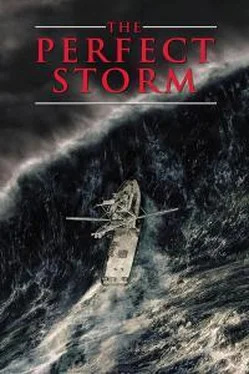Sebastian Junger - The Perfect Storm
Здесь есть возможность читать онлайн «Sebastian Junger - The Perfect Storm» — ознакомительный отрывок электронной книги совершенно бесплатно, а после прочтения отрывка купить полную версию. В некоторых случаях можно слушать аудио, скачать через торрент в формате fb2 и присутствует краткое содержание. Жанр: Триллер, Проза. Описание произведения, (предисловие) а так же отзывы посетителей доступны на портале библиотеки ЛибКат.
- Название:The Perfect Storm
- Автор:
- Жанр:
- Год:неизвестен
- ISBN:нет данных
- Рейтинг книги:3 / 5. Голосов: 1
-
Избранное:Добавить в избранное
- Отзывы:
-
Ваша оценка:
- 60
- 1
- 2
- 3
- 4
- 5
The Perfect Storm: краткое содержание, описание и аннотация
Предлагаем к чтению аннотацию, описание, краткое содержание или предисловие (зависит от того, что написал сам автор книги «The Perfect Storm»). Если вы не нашли необходимую информацию о книге — напишите в комментариях, мы постараемся отыскать её.
The Perfect Storm — читать онлайн ознакомительный отрывок
Ниже представлен текст книги, разбитый по страницам. Система сохранения места последней прочитанной страницы, позволяет с удобством читать онлайн бесплатно книгу «The Perfect Storm», без необходимости каждый раз заново искать на чём Вы остановились. Поставьте закладку, и сможете в любой момент перейти на страницу, на которой закончили чтение.
Интервал:
Закладка:
In February 1883, the 320-foot steamship Glamorgan was swept bow-to-stern by an enormous wave that ripped the wheelhouse right off the deck, taking all the ship's officers with it. She later sank. In 1966, the 44,000-ton Michelangelo, an Italian steamship carrying 775 passengers, encountered a single massive wave in an otherwise unremarkable sea. Her bow fell into a trough and the wave stove in her bow, flooded her wheelhouse, and killed a crewman and two passengers. In 1976, the oil tanker Cretan Star radioed, "... vessel was struck by a huge wave that went over the deck . . ." and was never heard from again. The only sign of her fate was a four-mile oil slick off Bombay.
South Africa's "wild coast," between Durban and East London, is home to a disproportionate number of these monsters. The four-knot Agulhas Current runs along the continental shelf a few miles offshore and plays havoc with swells arriving from Antarctic gales. The current shortens their wavelengths, making the swells steeper and more dangerous, and bends them into the fastwater the way swells are bent along a beach. Wave energy gets concentrated in the center of the current and overwhelms ships that are there to catch a free ride. In 1973 the 12,000-ton cargo ship Bencruachan was cracked by an enormous wave off Durban and had to be towed into port, barely afloat. Several weeks later the 12,000-ton Neptune Sapphire broke in half on her maiden voyage after encountering a freak sea in the same area. The crew were hoisted off the stern section by helicopter. In 1974, the 132,000-ton Norwegian tanker Wilstar fell into a huge trough ("There was no sea in front of the ship, only a hole," said one crew member) and then took an equally huge wave over her bow. The impact crumpled inch-thick steel plate like sheetmetal and twisted railroad-gauge I-beams into knots. The entire bow bulb was torn off.
The biggest rogue on record was during a Pacific gale in 1933, when the 478-foot Navy tanker Ramapo was on her way from Manila to San Diego. She encountered a massive low-pressure system that blew up to sixty-eight knots for a week straight and resulted in a fully developed sea that the Ramapo had no choice but to take on her stern. (Unlike today's tankers, the Ramapo's wheelhouse was slightly forward of amidships.) Early on the morning of February seventh, the watch officer glanced to stern and saw a freak wave rising up behind him that lined up perfectly with a crow's nest above and behind the bridge. Simple geometry later showed the wave to be 112 feet high. Rogue waves such as that are thought to be several ordinary waves that happen to get "in step," forming highly unstable piles of water. Others are waves that overlay long-distance swells from earlier storms. Such accumulations of energy can travel in threes—a phenomenon called "the three sisters"—and are so huge that they can be tracked by radar. There are cases of the three sisters crossing the Atlantic Ocean and starting to shoal along the loo-fathom curve off the coast of France. One hundred fathoms is six hundred feet, which means that freak waves are breaking over the continental shelf as if it were a shoreline sandbar. Most people don't survive encounters with such waves, and so firsthand accounts are hard to come by, but they do exist. An Englishwoman named Beryl Smeeton was rounding Cape Horn with her husband in the 1960s when she saw a shoaling wave behind her that stretched away in a straight line as far as she could see. "The whole horizon was blotted out by a huge grey wall," she writes in her journal. "It had no curling crest, just a thin white line along the whole length, and its face was unlike the sloping face of a normal wave.
This was a wall of water with a completely vertical face, down which ran white ripples, like a waterfall."
The wave flipped the forty-six-foot boat end over end, snapped Smeeton's harness, and threw her overboard.
Tommy Barrie had a similar experience off Georges Bank. He was laying-to in a storm when a wave clobbered him out of nowhere, imploding his windows. "There was this 'boom' and the Lexan window was blown right off," he says. "The window hit the clutch and so the clutch was pinned and we couldn't get her into gear. The boat's over a bit, layin' in a beam sea and shit flyin' everywhere—things that have never moved on that boat before goin' all over the place. The wave ripped the life raft off its mount and blew the front hatch open. It was dogged down, but there was so much water it blew it open anyway. I came up quick and radioed the Miss Millie: 'Larry we took a hell of a wave, stand by, I'm here.' I took the boat downsea and about ten minutes later the same wave hit him. His bird came out of the water and the hull took a big dent."
If a wave takes Billy's windows out, it would be similar to the one experienced by Smeeton or Barrie—big, steep, and unexpected. It's an awful scene to imagine: water knee-deep in the wheelhouse, men scrambling up the companionway, wind screaming through the blown-out window. If enough water gets in, it can make its way down to the engine room, soak the wiring, and take on an electric charge. The entire boat gets electrified; anyone standing in water gets electrocuted. A boat that loses her windows can start filling up with water in minutes, so two men tie safety lines to their waists and crawl out onto the whaleback deck with sheets of marine plywood. "The plywood acts like a kite, you have to manhandle the sonofabitch," says Charlie Reed. "It's a horrible thought, someone out there in that weather. As captain, it's your worst fear, someone goin' over the side."
It's hard to find a more dangerous job than venturing onto the whaleback during a storm to do a little carpentry. On land a loo-knot wind reduces people to a crawl; at sea it knocks you flat. The decks are awash, the boat is rolling, the spray is raking you like grapeshot. You work in the calm of the wave troughs and flatten yourself at the crests to keep from being blown off the boat. One man holds the plywood against the window while the other lines up a power drill with the holes in the wheelhouse and starts drilling. He drills one hole, hammers a bolt through, and then someone in the wheelhouse threads on the nut while the men on the outside keep drilling and bolting, drilling and bolting until the plywood is screwed down tight. Some captains put a piece of inner tube between the wood and steel to make it waterproof.
Although it's a suicidal job, crews that lose their windows almost always manage to get some plywood up, even if it means turning downsea to do it. After the plywood is bolted down, the crew starts bucket-bailing the wheelhouse and putting the cabin back in order. Maybe someone tries to wire the loran or radio up to a battery to see if he can get a signal. Billy starts shifting fuel from one tank to another, trying to trim the boat. Someone probably checks the engine room and work deck—are the scuppers clearing their water? Are the birds down? Is the fish hatch secure?
There's not much they can do at this point but head into the storm and hope they don't take any more big waves. If waves keep taking out their windows they could turn around and go downsea, but that generates a whole new set of problems. Several large waves could simply bury them, or the lazarette could flood, or sediment could get stirred up in the tanks and clog the fuel filters. If the ship motion is violent enough, the crew has to change the filters nonstop—pull them out, flush the sediment, put them back in again, over and over, as fast as they can. Or the engine stops and the boat goes over.
There's no question Billy would radio for help now if he had the capability. All he'd have to do is say "mayday," on channel 16 or 2182 kilohertz, and give his coordinates. Sixteen and 2182 are monitored by the Coast Guard, the military, and all oceangoing vessels; according to maritime law, any vessel that picks up a mayday must respond immediately, unless their own lives would be put in danger. The Coast Guard would send out an Aurora rescue plane to locate the Andrea Gail and circle her. A rescue-swimmer and helicopter crew would be placed on standby at the airbase outside Halifax. The Canadian Coast Guard cutter Edward Cornwallis would start steaming east out of Halifax on what would probably be a thirty-six-hour trip. The Triumph C, an oceangoing tug based at a drilling platform off Sable Island, would put to sea as well. The Contship Holland, the Zarah, and possibly the Mary T, would all try to converge on Billy. Once there, they wouldn't be able to leave until the Coast Guard signs them off.
Читать дальшеИнтервал:
Закладка:
Похожие книги на «The Perfect Storm»
Представляем Вашему вниманию похожие книги на «The Perfect Storm» списком для выбора. Мы отобрали схожую по названию и смыслу литературу в надежде предоставить читателям больше вариантов отыскать новые, интересные, ещё непрочитанные произведения.
Обсуждение, отзывы о книге «The Perfect Storm» и просто собственные мнения читателей. Оставьте ваши комментарии, напишите, что Вы думаете о произведении, его смысле или главных героях. Укажите что конкретно понравилось, а что нет, и почему Вы так считаете.












